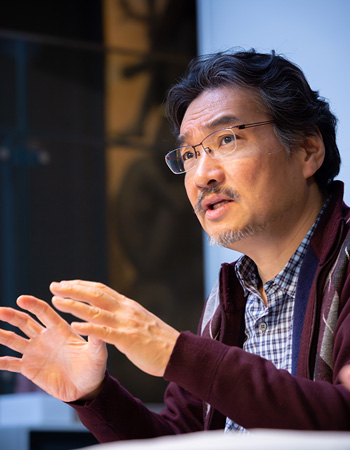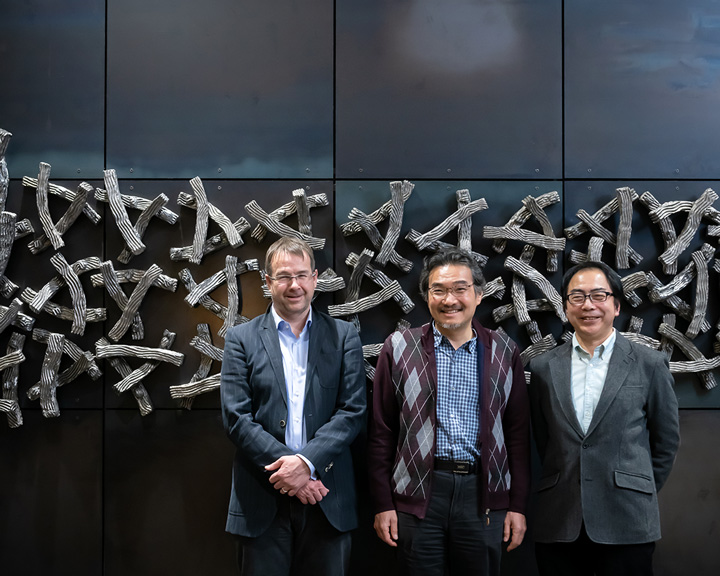- Home
- > Outreach
- > Publications
- > CONVERGENCE
- > Featured Topics
 Featured Topics
Featured Topics
When The Artificial Brain Says 'Sleepy'
Prof. Masashi Yanagisawa
Director, International Institute for Integrative Sleep Medicine (WPI-IIIS)
Prof. Tomonobu Nakayama
Deputy Director, International Center for Materials Nanoarchitectonics (WPI-MANA)
Prof. Tomonobu Nakayama, researching nanosystems at WPI-MANA. As we explore the possibility of an artificial brain using atomic switches, we focus our attention on "sleep" which is a characteristic of the brain of an organism. We visited Prof. Masashi Yanagisawa, Director of International Institute for Integrative Sleep Medicine (WPI-IIIS), University of Tsukuba, the world's leading sleep research institute, and Prof. Kaspar Vogt, Associate Professor of WPI-IIIS. Can we find commonalities between sleep and the artificial brain that WPI-MANA aims to develop? As we started talking, unexpected common points emerged.

■■■
What does it mean to get sleepy?

Masashi Yanagisawa
Director, International Institute for Integrative Sleep Medicine (WPI-IIIS), University of Tsukuba
Yanagisawa (Y) : The issue about sleep is that we do not actually know anything about it. There are two big questions. One is "Why should we sleep?" With regards to the brain, the neural activity does not slow down during sleep, and as measured in metabolic rate and blood flow, the activity of the most energy-consuming cerebral cortex does not decrease either.
Nakayama (N): The brain must take a sleep even though the energy consumption does not decrease...that is a question, right?
Y : An animal will die if it stays awake all the time. Sleep is essential to maintain life. But we cannot explain why. Firstly, we cannot explain what is happening in the brain during sleep, namely a function of sleep. "Why should we sleep?”is one big question.
N : What is known about the role of sleeping at present?
Y: We know many things about it fragmentarily. For example, it is well known that memory consolidation occurs during particularly deep sleep (slow wave sleep). Not only declarative memories, but also of "skills" such as driving, playing sports and musical instruments, are improved by sleeping overnight. A memory element of the barin is said to be the synapses. It is thought that the dynamics of synaptic connections is the actual state of memory, but we do not understand how sleep relates to it exactly.
N: Strengthening synapse connections to fix the memory while sleeping .... If we do that kind of work, I understand that the energy consumption is not reduced.
Y: Another big question is the regulation of sleep. In adults, the average of the required amount of sleep is said to be about 7 ± 1 hours per night, and staying awake all night results in sleeping longer and deeply during the next day. In other words, the longer you stay awake, the more the sleep need becomes stronger, and you get rid of it when you sleep. But we do not know what that sleep need is all about.
N: Revealing the secret of the sleep need is the key to understand why do we get sleepy, and how do we measure the necessity of sleeping... right?
Y: Yes. We know nothing regarding the physical entity of "drowsiness" and the biological mechanism in the brain. The brain seems to count how long you have been staying awake in the near past, but we do not know where this “integrator”is. We do not know how it is measured, where in the brain it is counted, and what the mechanism is.
N: The more I become to know, the more I confuse (laugh).
Y: Well, yes. We really do not know anything.
Nakayama (N): The brain must take a sleep even though the energy consumption does not decrease...that is a question, right?
Y : An animal will die if it stays awake all the time. Sleep is essential to maintain life. But we cannot explain why. Firstly, we cannot explain what is happening in the brain during sleep, namely a function of sleep. "Why should we sleep?”is one big question.
N : What is known about the role of sleeping at present?
Y: We know many things about it fragmentarily. For example, it is well known that memory consolidation occurs during particularly deep sleep (slow wave sleep). Not only declarative memories, but also of "skills" such as driving, playing sports and musical instruments, are improved by sleeping overnight. A memory element of the barin is said to be the synapses. It is thought that the dynamics of synaptic connections is the actual state of memory, but we do not understand how sleep relates to it exactly.
N: Strengthening synapse connections to fix the memory while sleeping .... If we do that kind of work, I understand that the energy consumption is not reduced.
Y: Another big question is the regulation of sleep. In adults, the average of the required amount of sleep is said to be about 7 ± 1 hours per night, and staying awake all night results in sleeping longer and deeply during the next day. In other words, the longer you stay awake, the more the sleep need becomes stronger, and you get rid of it when you sleep. But we do not know what that sleep need is all about.
N: Revealing the secret of the sleep need is the key to understand why do we get sleepy, and how do we measure the necessity of sleeping... right?
Y: Yes. We know nothing regarding the physical entity of "drowsiness" and the biological mechanism in the brain. The brain seems to count how long you have been staying awake in the near past, but we do not know where this “integrator”is. We do not know how it is measured, where in the brain it is counted, and what the mechanism is.
N: The more I become to know, the more I confuse (laugh).
Y: Well, yes. We really do not know anything.
Atomic switch, artificial brain, and sleep

Tomonobu Nakayama
Deputy Director, International Center for Materials Nanoarchitectonics (WPI-MANA)
National Institute for Materials Science (NIMS)
N: WPI-MANA has developed a completely new element called an atomic switch, which actuates by controlling the movement of atoms. This atomic switch has already been practically used as an ON-OFF switch element, however, we are researching on how to create an artificial brain with atomic switches. These switches do not only have ‘on’ and ‘off’ states, but also continuous intermediate states. They exhibit the interesting nature where the switching action and the on/off state are influenced by past actions. These "continuous intermediate states" and "behaviors dependent on past history” are similar to the characteristics of synapse. For example, if most people learn things intently, they tend to be able to recall them for a long time, and if they learn things less intently, they will forget it easily; the atomic switch is an element that has this kind of behavior.
Y: Well, that might be a new approach to understand the brain.
N: If we mention artificial brain, we immediately imagine AI. The current AI consists of a computer software and database, i.e. Soft AI. You can turn off the computer, and then Soft AI will stop functioning completely. But, the complete stop of the human brain means 'death'. That is, there is no complete stop in the human brain, but at least there is sleep instead. If these features are similar to those of the artificial brain we areabout to make, I think it will be completely different from Soft AI.
Y: In my opinion, the function of sleep with regard to the brain is maintenance, not in the switched-off state but in the offline state, disconnected from the outside world. I think that the situation is comparable to defragmentation or garbage collection on a computer.
N: It is a very interesting metaphor. We can see it as resolving computer storage fragmentation. We strengthen the system by stopping the input of external data and organizing internal memory.
Y: Well, that might be a new approach to understand the brain.
N: If we mention artificial brain, we immediately imagine AI. The current AI consists of a computer software and database, i.e. Soft AI. You can turn off the computer, and then Soft AI will stop functioning completely. But, the complete stop of the human brain means 'death'. That is, there is no complete stop in the human brain, but at least there is sleep instead. If these features are similar to those of the artificial brain we areabout to make, I think it will be completely different from Soft AI.
Y: In my opinion, the function of sleep with regard to the brain is maintenance, not in the switched-off state but in the offline state, disconnected from the outside world. I think that the situation is comparable to defragmentation or garbage collection on a computer.
N: It is a very interesting metaphor. We can see it as resolving computer storage fragmentation. We strengthen the system by stopping the input of external data and organizing internal memory.
Is synaptic behavior similar to that of atomic switches?
N : In atomic switches, synaptic-like plasticity※1 is represented as a change in conductance, that is, a single signal. On the other hand, synapses in the brain are complicated and involve multiple types of molecular transport/signaling. Right?
Y : If we describe synapse movement very simply, it will be like this. The synapse has a front (presynapse) and a back (postsynapse). Basically, when the action potential comes to the presynapse through the axon, neurotransmitter are released from synaptic vesicles. At the postsynapse, there is a receptor for the neurotransmitter, and a signal is transmitted. When the action potential of the postsynapse exceeds a certain threshold, postsynaptic cells fire. But, the amount of released neurotransmitters and receptors, threshold for the neuron to fire, and so on, are actually all variable and complicated in terms of quantity and time. However, it is an analog process overall, meaning that the stronger the stimulation, the stronger the connection formed and the strength of the synapse increases. It is similar to the atomic switch in that sense,in other words they both have analog aspects.
N : Your words are very encouraging to say that the atomic switch is even "roughly" similar to a synapse.
Y : But if I dare say that, basically each synapse is not reliable (laugh). Furthermore, even at the level of each neuron that has about a thousand synapses, it is not very accurate. Most macroscopic activities performed in the brain, like thoughts and computation, are produced by ensemble of many neurons, thereby maintaining a certain accuracy. We, living things make mistakes but maintain a certain degree of accuracy enabling to survive.
N : That is exactly the point that excites nanomaterial researchers. Generally, it is thought that if you make extremely small things in nanoscale, it becomes precise and operation will be fast and reliable. This is correct in a sense. But the smaller the size, the greater the fluctuation. If I am told to prepare one million atomic switches with exactly the same performance and operate them precisely, I will be distressed. In order to hide performance variations (laugh), I will have to use only clear-cut states, like‘on’and‘off.' If elements with somewhat varied characteristics can be operated on with a certain accuracy by aggregating them as an ensemble, a new possibility of nanosystems will be opened up.
Y : If we describe synapse movement very simply, it will be like this. The synapse has a front (presynapse) and a back (postsynapse). Basically, when the action potential comes to the presynapse through the axon, neurotransmitter are released from synaptic vesicles. At the postsynapse, there is a receptor for the neurotransmitter, and a signal is transmitted. When the action potential of the postsynapse exceeds a certain threshold, postsynaptic cells fire. But, the amount of released neurotransmitters and receptors, threshold for the neuron to fire, and so on, are actually all variable and complicated in terms of quantity and time. However, it is an analog process overall, meaning that the stronger the stimulation, the stronger the connection formed and the strength of the synapse increases. It is similar to the atomic switch in that sense,in other words they both have analog aspects.
N : Your words are very encouraging to say that the atomic switch is even "roughly" similar to a synapse.
Y : But if I dare say that, basically each synapse is not reliable (laugh). Furthermore, even at the level of each neuron that has about a thousand synapses, it is not very accurate. Most macroscopic activities performed in the brain, like thoughts and computation, are produced by ensemble of many neurons, thereby maintaining a certain accuracy. We, living things make mistakes but maintain a certain degree of accuracy enabling to survive.
N : That is exactly the point that excites nanomaterial researchers. Generally, it is thought that if you make extremely small things in nanoscale, it becomes precise and operation will be fast and reliable. This is correct in a sense. But the smaller the size, the greater the fluctuation. If I am told to prepare one million atomic switches with exactly the same performance and operate them precisely, I will be distressed. In order to hide performance variations (laugh), I will have to use only clear-cut states, like‘on’and‘off.' If elements with somewhat varied characteristics can be operated on with a certain accuracy by aggregating them as an ensemble, a new possibility of nanosystems will be opened up.
Computers are using excessive energy
Y : Classical computers, now in practical use, are very accurate but seem to waste a lot of energy.
N : Exactly. Lots of energy is very necessary to control all the elements as expected.
Y : That is a big difference from organisms. The biological brain is a system that works properly as an ensemble by cleverly organizing elements that are not very accurate as I told.
N : Is that a biological strategy to give fluctuations to the system moderately, and find a more stable and safe condition?
Y : Well, maybe yes. In that regard, I think that there is a possibility that sleep is involved.
N : As computer performance gets better and better, Soft AI gets to use more and more databases, and it will consume more energy. To avoid this, a system like biological brain would be required as a new kind of computer which provides reasonably acceptable solutions. And sleep will play an importat role in operating the system.
Y : Yes, I believe so.
N : Exactly. Lots of energy is very necessary to control all the elements as expected.
Y : That is a big difference from organisms. The biological brain is a system that works properly as an ensemble by cleverly organizing elements that are not very accurate as I told.
N : Is that a biological strategy to give fluctuations to the system moderately, and find a more stable and safe condition?
Y : Well, maybe yes. In that regard, I think that there is a possibility that sleep is involved.
N : As computer performance gets better and better, Soft AI gets to use more and more databases, and it will consume more energy. To avoid this, a system like biological brain would be required as a new kind of computer which provides reasonably acceptable solutions. And sleep will play an importat role in operating the system.
Y : Yes, I believe so.
Synapses during sleep operate with a dynamism

Kaspar Vogt
Associate Professor, International Institute for Integrative Sleep Medicine (WPI-IIIS), University of Tsukuba
Y : With regards to the function of sleep, there is a hypothesis called the Synaptic Homeostasis Theory. In that hypothesis, as long as a person is awake, in other words conscious, his/her brain continues to respond in realtime to constantly changing input. Continuing that, the average synaptic intensity in the brain gradually increases. However, because it cannot keep increasing forever, at some point, it will collapse eventually. In order not to collapse, our brain counts something that increase along with the average synaptic intensity and switch to the state of sleep. That is the essence of the hypothesis.
N : Well, I certainly get tired when I think too much... It is not an abstract thing "too much thinking", but some physical quantity equivalent to it is changing.
Y : Yes, when switching to the state of sleep, renormalization (optimization / leveling) occurs. Because it is necessary to be unbiased when renormalizing occurs, the brain goes offline state, that is, the state of unconscious sleep. Very plausible hypothesis, but there is still no rigorous biological proof so far.
Vogt (V) : The important thing is that renormalization must be done without erasing memory. If memory is lost, there is no point formatting it. Either way, I do not think that memory can be completely erased. Some say that renormalization could mean introduction randomness into the network. If so, the random activities of neurons do not make sense, and we cannot do normal activities. So, at that time, we may need to lose consciousness. But this has not yet been proven. In the end, we have not understood the detailed mechanism of what kind of synapse renormalization occurs at which time yet.
N : Very interesting. It is definitely troubling if we are in conscious state while neurons work randomly. It would be very dangerous if we act under the random commands from the brain. Do we need to lose consciousness in order to live? However, in such a state with or without consciousness, the activity dynamics of the brain should be different.
Y : That is exactly what Associate Professor Vogt is attempting to unravel in one of his recent works. He statistically measured the action potential of neurons. And his conclusion was that the entropy of the neuron spikes during slow wave sleep was higher than that of the waking state. This is a result that does not conflict with the story that the brain is more active while sleeping.
V : Interestingly, the brain works in several ways. When awake, you can predict firing pattern of neurons by giving clear input to them or visual cortex. If there is no clear input, it shows an unpredictable firing pattern even when awake.
N : Then, how about the firing pattern during sleep?
V : At the moment of entering slow wave sleep, the firing pattern changes dramatically. During slow wave sleep, unpredictable firing pattern appears, while the“on”state (active) and“off”state (silence) of neurons in the cerebral cortex are strongly synchronized. This pattern is very similar to that of awakening, but it shows important differences. In that state, individual neurons were not ignited independently, but a large number of neurons were operating at the same time. Our research found that the pattern in which neurons synchronize is more random in slow wave sleep than during awakening.
N : The pattern of neuronal activities get more randomly when entering slow wave sleep, but it is a phenomenon accompanied by neural entrainment.
V : Yes, the interlocking patterns of neurons in the cerebral cortex during wakening and during slow wave sleep are quite different.
N : During slow wave sleep, the physical connection between neurons are maintained?
V : It is known that the conjugation between neurons is quite dynamic.
N : You mean, although it is synchronized, the conjugation between the neurons changes dynamically and controls the whole system.
V : That is right. I am not sure when the physical network actually changes. What we now know is that the individual connections between neurons and collective activities are completely different things.
N : Well, I certainly get tired when I think too much... It is not an abstract thing "too much thinking", but some physical quantity equivalent to it is changing.
Y : Yes, when switching to the state of sleep, renormalization (optimization / leveling) occurs. Because it is necessary to be unbiased when renormalizing occurs, the brain goes offline state, that is, the state of unconscious sleep. Very plausible hypothesis, but there is still no rigorous biological proof so far.
Vogt (V) : The important thing is that renormalization must be done without erasing memory. If memory is lost, there is no point formatting it. Either way, I do not think that memory can be completely erased. Some say that renormalization could mean introduction randomness into the network. If so, the random activities of neurons do not make sense, and we cannot do normal activities. So, at that time, we may need to lose consciousness. But this has not yet been proven. In the end, we have not understood the detailed mechanism of what kind of synapse renormalization occurs at which time yet.
N : Very interesting. It is definitely troubling if we are in conscious state while neurons work randomly. It would be very dangerous if we act under the random commands from the brain. Do we need to lose consciousness in order to live? However, in such a state with or without consciousness, the activity dynamics of the brain should be different.
Y : That is exactly what Associate Professor Vogt is attempting to unravel in one of his recent works. He statistically measured the action potential of neurons. And his conclusion was that the entropy of the neuron spikes during slow wave sleep was higher than that of the waking state. This is a result that does not conflict with the story that the brain is more active while sleeping.
V : Interestingly, the brain works in several ways. When awake, you can predict firing pattern of neurons by giving clear input to them or visual cortex. If there is no clear input, it shows an unpredictable firing pattern even when awake.
N : Then, how about the firing pattern during sleep?
V : At the moment of entering slow wave sleep, the firing pattern changes dramatically. During slow wave sleep, unpredictable firing pattern appears, while the“on”state (active) and“off”state (silence) of neurons in the cerebral cortex are strongly synchronized. This pattern is very similar to that of awakening, but it shows important differences. In that state, individual neurons were not ignited independently, but a large number of neurons were operating at the same time. Our research found that the pattern in which neurons synchronize is more random in slow wave sleep than during awakening.
N : The pattern of neuronal activities get more randomly when entering slow wave sleep, but it is a phenomenon accompanied by neural entrainment.
V : Yes, the interlocking patterns of neurons in the cerebral cortex during wakening and during slow wave sleep are quite different.
N : During slow wave sleep, the physical connection between neurons are maintained?
V : It is known that the conjugation between neurons is quite dynamic.
N : You mean, although it is synchronized, the conjugation between the neurons changes dynamically and controls the whole system.
V : That is right. I am not sure when the physical network actually changes. What we now know is that the individual connections between neurons and collective activities are completely different things.
Considering the dynamics
N : What if all synapses of the human brain worked individually and precisely, what would happen? Can we get smarter (laugh)?
Y : Who knows (laugh). As I see it, so-called flexibility would disappear. The great thing about living beings is that they can adapt the environment even if it changes a little bit, without being taught anything.
N : Keep the brain flexible... The brain made of the synapses that works so accurate seems to be a stubborn thing that only works deterministically.
Y : Yes. It excels in doing one thing, but it cannot do anything if unexpected thing happens. It is not the way actual life is doing.
N : It is one of the problems AI currently has.
Y : Yes. In short, the current AI is very good at solving well-defined problems. But the problem with the current AI right now is that it cannot tell what the problem is or what is interesting to solve.
N : That is so true. You said, "each synapse is not very accurate in a sense.” Does that part lead to this flexibility?
Y : Well, yes.
N : Systems with flexible functionality could be developed by making aggregates of nano-parts with varying properties. This idea could give a new direction to many material researchers. Even though there is a huge gap between sleep science and materials science, it is very interesting that there is a kind of same way of thinking.
Y : The research subjects are quite different, but the concepts seem to be similar.
N : Yes, our research fields share the similar concept towards the understanding how components make the ensemble.
Y : Yes, that is right.
N : Modern technologies are based on bottom-up approach, namely building up from each component one by one. For developing an artificial brain, we might need to take another approach from the dynamics aspect to design it. When an artificial brain that says“I’m sleepy”is created, we will make big progress both in the sleep science and the materials science.
※1 :Synaptic plasticity The characteristics of the synapse, which is the transmitter of information between neurons, changes from moment to moment in adaptation to various signals from outside (for example, sensory stimulation). It is thought to have an important role in memory and learning.
Y : Who knows (laugh). As I see it, so-called flexibility would disappear. The great thing about living beings is that they can adapt the environment even if it changes a little bit, without being taught anything.
N : Keep the brain flexible... The brain made of the synapses that works so accurate seems to be a stubborn thing that only works deterministically.
Y : Yes. It excels in doing one thing, but it cannot do anything if unexpected thing happens. It is not the way actual life is doing.
N : It is one of the problems AI currently has.
Y : Yes. In short, the current AI is very good at solving well-defined problems. But the problem with the current AI right now is that it cannot tell what the problem is or what is interesting to solve.
N : That is so true. You said, "each synapse is not very accurate in a sense.” Does that part lead to this flexibility?
Y : Well, yes.
N : Systems with flexible functionality could be developed by making aggregates of nano-parts with varying properties. This idea could give a new direction to many material researchers. Even though there is a huge gap between sleep science and materials science, it is very interesting that there is a kind of same way of thinking.
Y : The research subjects are quite different, but the concepts seem to be similar.
N : Yes, our research fields share the similar concept towards the understanding how components make the ensemble.
Y : Yes, that is right.
N : Modern technologies are based on bottom-up approach, namely building up from each component one by one. For developing an artificial brain, we might need to take another approach from the dynamics aspect to design it. When an artificial brain that says“I’m sleepy”is created, we will make big progress both in the sleep science and the materials science.
※1 :Synaptic plasticity The characteristics of the synapse, which is the transmitter of information between neurons, changes from moment to moment in adaptation to various signals from outside (for example, sensory stimulation). It is thought to have an important role in memory and learning.

In front of the artwork "Dorveille" at WPI-IIIS

